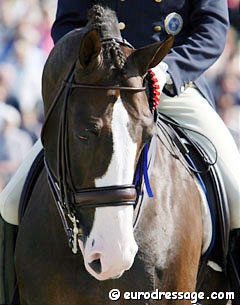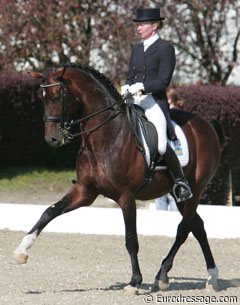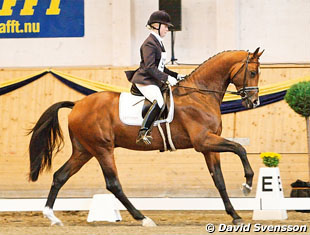
Kim Lundin frequently writes for major Swedish Horse Magazine Tidningen Ridsport on topics such as breeding and dressage. She is a representative of the interested and educated spectator, not a judge nor a breeder, but with opinions.
Following top dressage as closely as possible, Kim also enjoys breeding statistics on a Friday night as any true nerd.
Swedish dressage breeding has historically been closely connected with the sport. Swedish dressage riders used to compete on Swedish Warmblood (SWB) horses and some of the most successful stallions participated in the highest level of dressage competitions like World Championships and Olympic Games. I use past tense as it seems to be the end of an era when Jan Brink and much missed poster-boy Briar decided to quit while still being in the Top-10. The dynamic duo represented the best SWB could produce almost twenty years ago and they went beyond all our expectations. Briar (by Magini x Krocket) was winner of the stallion test as a 4-year old, a double talent with evident jumping skills. Since 1995 he has sired over 600 offspring and since 2006 is recognized as an elite stallion.
Every year since his breakthrough the stallion test in February awakens our hope – will we see a new star? Not only for breeding but with great success in sport? Why? It’s obvious, you just have to go back to the 2004 Olympics in Athens when the Swedish team consisted of three SWB approved stallions – Briar, Sack and Guiness - and only one team horse born abroad (Just Mickey). Well, Guiness was born Danish but he has always been counted as a Swede. Sweden finished sixth that year and has done better and worse since but we have never had more SWB stallions or horses on the team since Athens. Is it vital to have approved stallions on the team? No, of course not but it is great marketing for the breeding association; a fact Jan Brink understands very well - now a board member of the Swedish Warmblood Association. If not stallions, SWB horses competing at high level with Swedish riders as well as foreign riders are the cloud nine we all wish for. If we only had a wishing well deep enough...
So has Swedish dressage breeding gone down the drain these last years? According to WBFSH ranking Yes – but who cares about statistics? Hard to say – we keep getting graphs and diagrams from SWB how much the breeding progress is moving upwards, constantly improving. It’s just that there is no visible proof in the sport. Swedish team riders’ use horses from other breeding associations; at the young horse championships we manage to qualify one or maybe two horses into the final fifteen. And finally few SWB horses compete under foreign riders. At WEG there were two: thanks to Norway and Israel! Is this evidence of poor quality of the Swedish dressage horses? Not necessarily, I am merely pointing out the obvious lack of automatic marketing of the brand which success in competition brings.
There is light at the end of the tunnel of course. On the stallion side we have Bocelli (by Don Schufro – Bernstein), winner in 2003 and climbing upwards in Grand Prix. He is regarded as a true Swedish Warm blood as he was born in Sweden from a pre-approved stallion. Although one could argue differently as Don Schufro is the pride and joy of Denmark with truly German origins... Race and association today is a matter of the all-important administrative aspect – where to register.
 Bocelli with rider Rose Mathiesen is currently ranked number seven in Sweden and the stallion is the best placed SWB horse on our national ranking. In the top 25 there are only nine SWB’s and here lies the essence of the problem. There simply aren’t enough SWB horses ridden at high level to say anything about the quality. In Sweden, we do not see many horses reaching Grand Prix at the age of eight. Those in that top 25 today also represent an older generation of stallions; Briar, Cortez and Warsteiner. But can it be another situation again in a couple of years, can the pendulum swing back to riders choosing SWB? Well, if SWB horses are up to par, for sure – and that is for the Swedish breeders to prove. Because most riders and fans of the sport – they really don’t care for the branding on a horse if the right qualities and performance is present. But for a breeding association to be left without the marketing by successful riders is a nightmare. You can only talk about figures and breeding enhancements up to a point but iit is what happens between the white fences that counts.
Bocelli with rider Rose Mathiesen is currently ranked number seven in Sweden and the stallion is the best placed SWB horse on our national ranking. In the top 25 there are only nine SWB’s and here lies the essence of the problem. There simply aren’t enough SWB horses ridden at high level to say anything about the quality. In Sweden, we do not see many horses reaching Grand Prix at the age of eight. Those in that top 25 today also represent an older generation of stallions; Briar, Cortez and Warsteiner. But can it be another situation again in a couple of years, can the pendulum swing back to riders choosing SWB? Well, if SWB horses are up to par, for sure – and that is for the Swedish breeders to prove. Because most riders and fans of the sport – they really don’t care for the branding on a horse if the right qualities and performance is present. But for a breeding association to be left without the marketing by successful riders is a nightmare. You can only talk about figures and breeding enhancements up to a point but iit is what happens between the white fences that counts.
The challenge for the breeders is huge: produce attractive horses in a shrinking market place and convince riders to cut their own diamonds in the rough. Today the dressage oriented breeders hold about 40 % of the breeding base. In rough figures there will be around 1200 foals registered next year with genes for dressage (about 1700 with jumping heritage). The figure has been decreasing since 2007 with over 20%. SWB often states that we have excellent conditions for breeding horses, and yes there is plenty of grazing land in Sweden. Sweden is very loooong, in the south it is crowded with horse farms but as soon as you travel north, up the country, more than 300,000 horses are scattered all over the place.
On average, a Swedish breeder sees fewer horses than colleagues in Denmark and Germany due to geographical distance and lack of breeding events. When you compare your own product with the closest neighbours it is difficult to judge whether you have a competitive result from your own efforts. There are breeders who go to all the international events and see lots of dressage prospects, but they are in minority. Danish judge and Chairman Poul Graugaard of the DWB stallion committee stated that the quality of this year’s foals has improved compared to 2007 when he last judged in Sweden but the mares are still a bit behind in quality. With influence from new high quality though mainly foreign stallions – the crop has improved. Now, each breeder should take a close look at the mare – is she good enough in terms of conformation, gaits and willingness to work? I truly hope Mr Graugaard is right and UVM 2015 will be a year to remember for SWB!
On average, a Swedish breeder has fewer mares compared his European breeder colleagues. This makes breeding more based on emotional decisions than business concerns. There is a difference if you depend on your production result for your livelihood like a professional breeder or if you enjoy having foals on your land, two extremes of course but still valid. Thus, if offered a low price for your product, it is offensive rather than a sign of the times. That attitude has to be dropped - get real and deal with it or leave the breeding business.
 The first real indication for a breeder, whether it is a rough diamond or a cubic zirconia in the barn is the 3-year old test. The young horses are shown in hand in trot and walk, canter and jumping in freedom and receive scores on conformation, gaits and jumping skill. The tests are performed in April-May; a result above 47 points (60 max.) gives a ticket to the championships in October. Here dressage horses are judged under rider. The majority of the horses participating in the spring are SWB, born and bred, in the autumn show 2009 it was 90 %. But among the ten finalists you find three foreign bred horses, including the winner Bellagio. He was approved in February as a stallion and will make an excellent contribution to Swedish breeding with his genes, no doubt and no objection whatsoever. This is not a one-time thing, this is a pattern. If you buy a quality commodity abroad, you will take sufficient measures to insure that its value increases. In other words, these young imported horses receive the best possible training and care and it works. An owner is more inclined to invest in training than an average Swedish breeder.
The first real indication for a breeder, whether it is a rough diamond or a cubic zirconia in the barn is the 3-year old test. The young horses are shown in hand in trot and walk, canter and jumping in freedom and receive scores on conformation, gaits and jumping skill. The tests are performed in April-May; a result above 47 points (60 max.) gives a ticket to the championships in October. Here dressage horses are judged under rider. The majority of the horses participating in the spring are SWB, born and bred, in the autumn show 2009 it was 90 %. But among the ten finalists you find three foreign bred horses, including the winner Bellagio. He was approved in February as a stallion and will make an excellent contribution to Swedish breeding with his genes, no doubt and no objection whatsoever. This is not a one-time thing, this is a pattern. If you buy a quality commodity abroad, you will take sufficient measures to insure that its value increases. In other words, these young imported horses receive the best possible training and care and it works. An owner is more inclined to invest in training than an average Swedish breeder.
So do we have quality dressage horses in Sweden? For sure but right now we lack the visible proof of their quality compared to others whose competition results abroad you see. If our riders can perform well on foreign horses, surely they can do it on SWB’s or am I missing something? If TellWell is good enough for Laura Bechtolsheimer, surely there are others? Just wait a little longer and things will get better, we must believe that and act accordingly. I am an optimist. It can certainly not be much worse than a place 11th ranking on the WBFSH-chart from august 2010.
On the other hand – a good horse has no colour, no papers, no branding. It’s just a good horse and personally, this is where my passion lies. No borders, no branding – just quality horses combined to be even better sports athletes. But Utopia is not within reach.
Check out Eurodressage's "Guest Columnists of the Week"